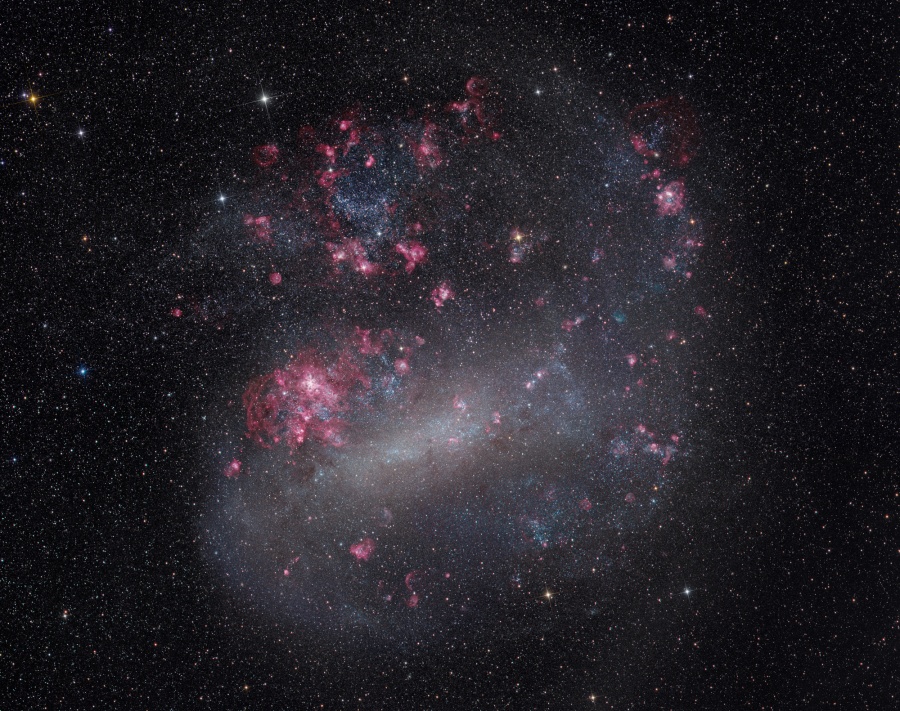Kidding aside, your typical observer probably knows NGC 1501 + NGC 1502 and NGC 2403 from the constellation. What one really shouldn't miss are the three fine and bright IC galaxies (IC 334, IC 342 and IC 356), fairly recently discovered open cluster Alessi 2 and a huge bunch of fine NGC galaxies worth browsing! Be sure to check out NGC 2366 - 3 bright HII regions (around 12th magnitude!) visible better than the parent galaxy itself. With larger apertures you can try to locate the elusive EGB 4, try to see the spiral structure in NGC 1530, NGC 1961 and NGC 2146 or zoom in on IC 361's tiny stars glittering with stardust. Without further ado, here are some of the treasures from Camelopardalis.
 |
Alessi 2
Size: 30' Type: IV 3 m Notes: Br * 8.8 |
 |
EGB 4 (Ellis-Grayson-Bond 4 / PK 144+24.1)
Magnitude: 12.5 (v) Size: 1.7' Type: ? Notes: Central star 12.7 (v), very low surface brightness. |
 |
GSC 3719-1528 group
Size: 0.2' Type: II 1 p (asterism) Notes: Br * 13.4 |
 |
IC 334
Magnitude: 11.3 (v) Surface brightness: 12.9 Size: 2.5' x 2.1' Type: I/P Notes: Material bridge(?) racing towards south. |
 |
IC 342
Magnitude: 8.4 (v) Surface brightness: 14.9 Size: 21.4' x 20.9' Type: SBc |
 |
IC 356 (Arp 213)
Magnitude: 10.6 (v) Surface brightness: 13.9 Size: 5.9' x 3.9' Type: Sb/P |
 |
IC 361
Magnitude: 11.7 (v) Size: 7.0' Type: II 1 r Notes: Br * 14.0 |
 |
IC 3568 (UGC 7731)
Magnitude: 10.6 (v) Size: 18" x 18" Type: 2 (2a) Notes: Central star 11.4 (v). |
 |
Mayer 2 + Sh2-207
Size: 3.0'
Type: III 1 p n Notes: Surrounded by emission nebula Sh2-207. |
 |
NGC 1501
Magnitude: 11.5 (v)
Size: 52.0" Type: 3 Notes: Central star 14.4 (v). |
 |
NGC 1502
Magnitude: 6.9 (v)
Size: 7.0' Type: I 3 m Notes: Br * 9.2 |
 |
NGC 1530
Magnitude: 11.5 (v)
Surface brightness: 13.9 Size: 4.4' x 2.5' Type: SBb |
 |
NGC 1560
Magnitude: 11.4 (v) Surface brightness: 14.4 Size: 9.8' x 1.5' Type: Scd |
 |
NGC 1569 (Arp 210)
Magnitude: 11.0 (v) Surface brightness: 12.9 Size: 3.7' x 1.8' Type: IBm |
 |
NGC 1961 (Arp 184)
Magnitude: 11.0 (v)
Surface brightness: 13.7 Size: 4.5' x 3.1' Type: SBbc |
 |
NGC 2146
Magnitude: 10.6 (v) Surface brightness: 13.7 Size: 5.4' x 2.9' Type: SBab/P |
 |
NGC 2366
Magnitude: 11.1 (v) Surface brightness: 14.5 Size: 8.1' x 3.0' Type: IBm Notes: NGC 2366 = three giant H II regions SW side of the galaxy, NGC 2363 = another H II region to the W. |
 |
NGC 2403
Magnitude: 8.9 (v) Surface brightness: 14.4 Size: 23.4' x 11.8' Type: SBc |
 |
NGC 2460
Magnitude: 11.8 (v)
Surface brightness: 13.3 Size: 2.5' x 1.9' Type: Sab Notes: Interacting pair with IC 2209 (lower right), LEDA 213434 (above NGC 2460) is a background galaxy. |
 |
NGC 2633 & NGC 2634 (Arp 80)
Magnitude: 12.2 (v) & 12.0 (v) Surface brightness: 13.6 & 13.1 Size: 2.3' x 1.5' & 1.7' x 1.6' Type: SBb/P & E1 Notes: NGC 2634A = 13.5 (v) magnitude. |
 |
NGC 2655 (Arp 225)
Magnitude: 10.1 (v) Surface brightness: 13.2 Size: 4.9' x 4.1' Type: SB0-a |
 |
Stock 23
Size: 28' Type: II 3 p n Notes: Br * 7.6 |
 |
Tombaugh 5 Magnitude: 8.4 (v) Size: 15' Type: III 2 r Notes: Br * 14.0 |
References
[1] http://en.wikipedia.org/wiki/Camelopardalis
Images courtecy of the Digitized Sky Survey (STScI)
Magnitude data from "Revised NGC/IC Data 2013" by Dr. Wolfgang Steinicke


















